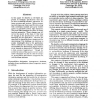ECOWS
2009
Springer
14 years 2 months ago
2009
Springer
—Recently, Semantic Web Services have been increasingly adopted to search, access and manipulate information made available from autonomous and heterogeneous systems interacting ...
VLDB
1991
ACM
14 years 3 months ago
1991
ACM
In this paper we describe a rule-based approach to semantic specification that can be used to establish semantic agreement between a source and receiver. Query processing techniqu...
SIGLEX
1991
14 years 3 months ago
1991
The lexical entry for a word must contain all the information needed to construct a semantic representation for sentences that contain the word. Because of that requirement, the f...
SIGLEX
1991
14 years 3 months ago
1991
This paper argues for a two-level theory of semantics as opposed to a one-level theory, based on the example of the system of temporal and durationM connectives. Instead of identi...
DOOD
1995
Springer
14 years 3 months ago
1995
Springer
Semantics represents a major problem area for active databases inasmuch as (i) there is l framework for defining the abstract semantics of active rules, and (ii) the various syst...
LCTRTS
2000
Springer
14 years 3 months ago
2000
Springer
This paper presents a general approach to automatically validate code-improving transformations on low-level program representations. The approach ensures the correctness of compi...
ESWS
2006
Springer
14 years 3 months ago
2006
Springer
Functional descriptions are a central pillar of Semantic Web services. Disregarding details on how to invoke and consume the service, they shall provide a black box description for...
ESWS
2006
Springer
14 years 3 months ago
2006
Springer
Abstract. Semantic Web Services were developed with the goal of automating the integration of business processes on the Web. The main idea is to express the functionality of the se...
ESWS
2006
Springer
14 years 3 months ago
2006
Springer
The Semantic Web (SW) offers an opportunity to develop novel, sophisticated forms of question answering (QA). Specifically, the availability of distributed semantic markup on a lar...
ESWS
2006
Springer
14 years 3 months ago
2006
Springer
Abstract. Automatic extraction of semantic relationships between entity instances in an ontology is useful for attaching richer semantic metadata to documents. In this paper we pro...

